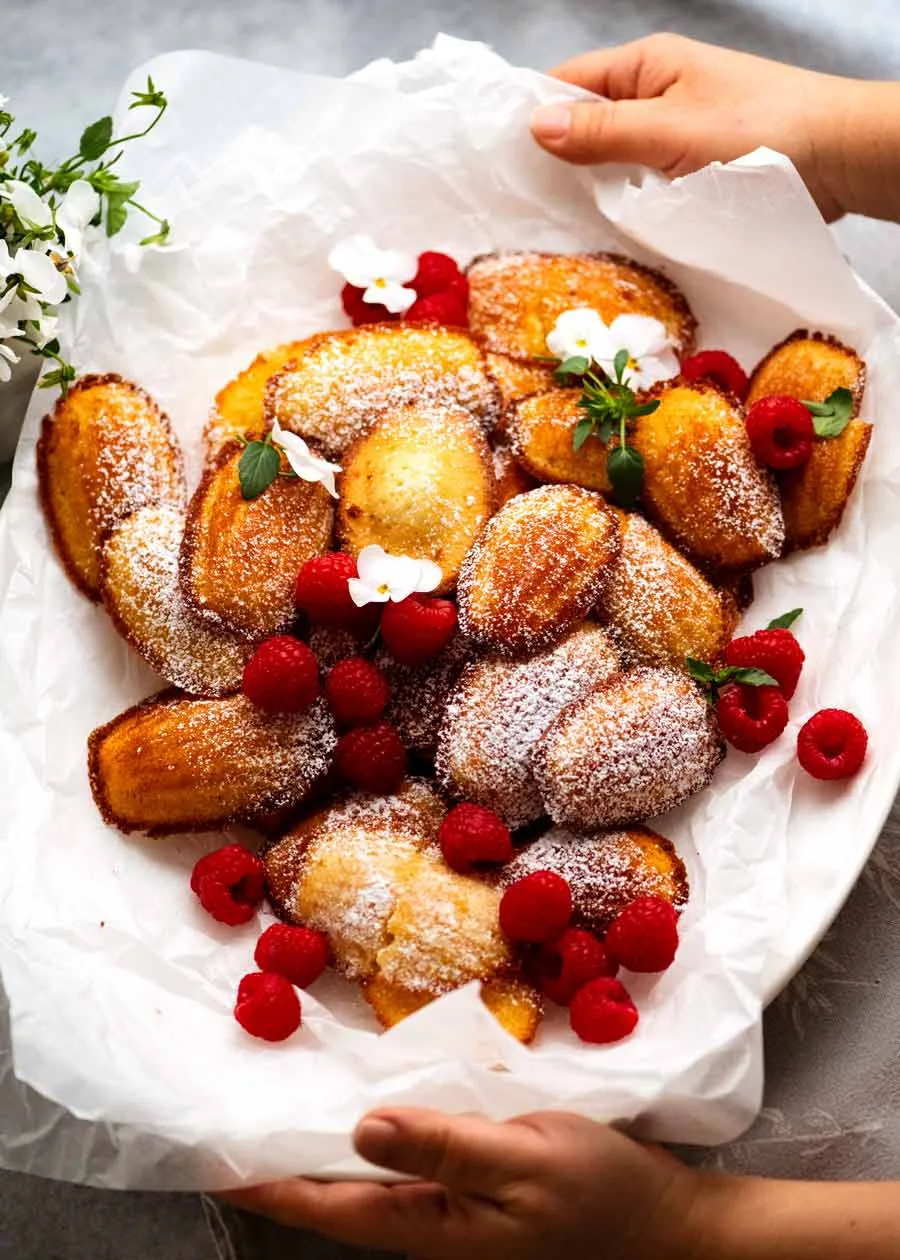French cuisine is known worldwide for its rich flavors and sophisticated techniques. Whether you’re a seasoned chef or just starting to explore cooking, there are countless traditional French recipes that can add a touch of elegance to your meals.
This collection of 30 traditional French recipes will help you discover the timeless flavors and culinary techniques of France. From hearty stews to delicate pastries, you’ll find a variety of dishes that are both delicious and achievable in your kitchen.
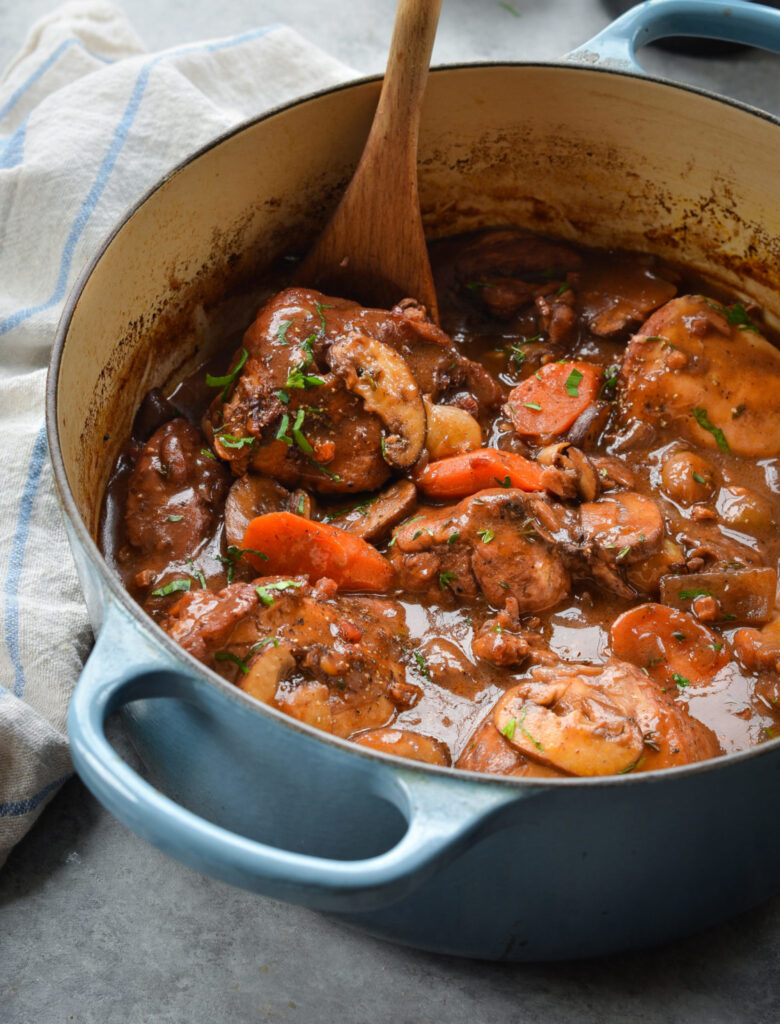
1) Coq au Vin
Coq au Vin is a classic French dish that translates to “chicken in wine.” It is a flavorful stew where chicken is braised slowly in red wine, often with brandy, to create a rich sauce.
To start, season your chicken with salt and pepper. Marinate it with wine, bay leaf, and thyme for at least 30 minutes.
Cook bacon or pancetta in a Dutch oven until crispy. Remove the bacon but leave the fat in the pot. Brown the chicken in this fat until it has a nice color.
Add onions, garlic, carrots, and celery to the pot. Pour in red wine and a bit of Cognac. Let it simmer and then move it to the oven for about 45 minutes.
Serve with mushrooms and pearl onions for a dish full of tender meat and rich, savory flavors. This meal pairs well with crusty bread or mashed potatoes.
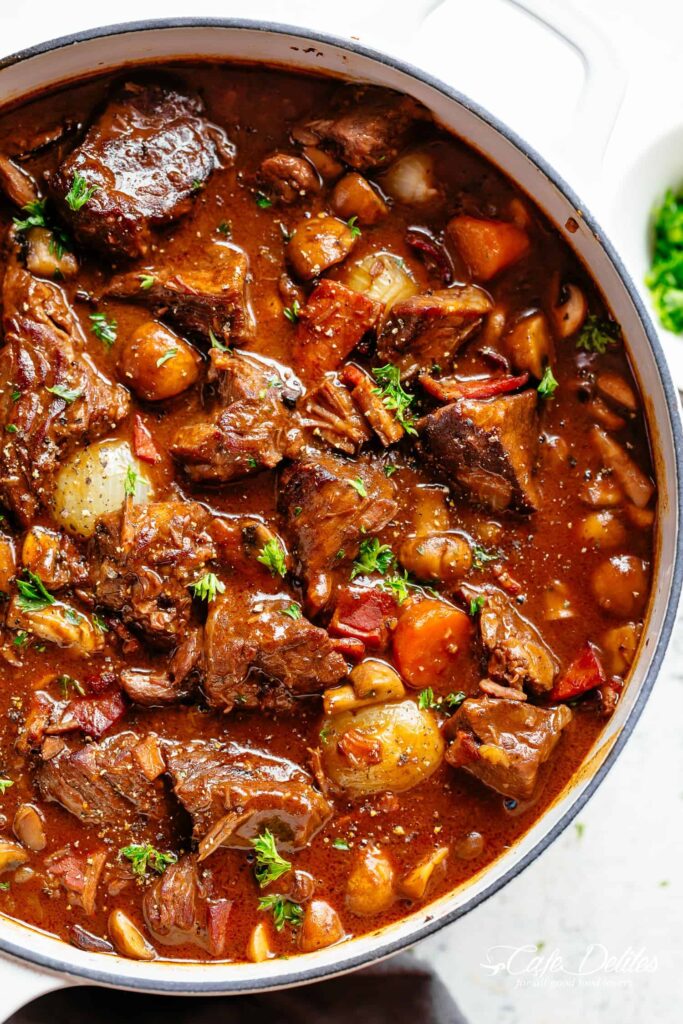
2) Boeuf Bourguignon
Boeuf Bourguignon is a classic French dish that turns beef into a tender, flavorful delight. You begin by browning chunks of beef in a Dutch oven. This step ensures the meat maintains a deep, rich flavor.
Next, add garlic, carrots, and pearl onions to the pot. Cook these vegetables until they start to glisten. This mix enhances the taste of the stew.
Pour in red wine and bring it to a rapid boil. This helps to deglaze the pot, lifting the browned bits that add even more flavor. Add beef broth, tomato paste, and seasonings.
Reintroduce the beef and bacon to the pot, and then cover it. Place it on the middle rack of your oven and bake for 2-3 hours. This long, slow cooking process makes the beef incredibly tender.
Lastly, you can add mushrooms to the mix. Sauté them in a separate pan before adding them to the stew for additional texture and flavor. Serve your Boeuf Bourguignon hot, ideally with a side of crusty bread or mashed potatoes. This dish exemplifies the heartiness and richness of French cuisine.
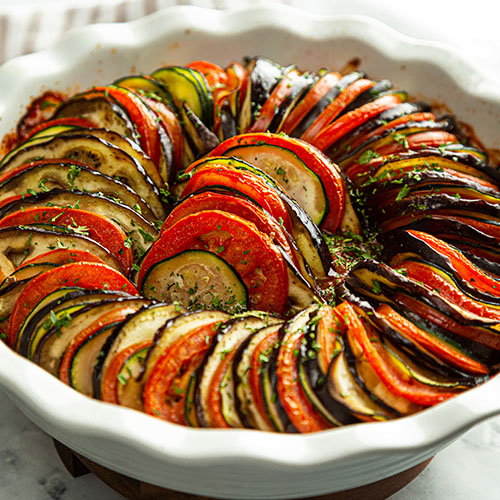
3) Ratatouille
Ratatouille is a classic French vegetable stew from Provence. It’s a bright and colorful dish, bursting with flavor from fresh ingredients.
You start by chopping and preparing the vegetables. Common ingredients include eggplant, zucchini, bell peppers, onions, and tomatoes. Each vegetable is cooked separately to ensure they retain their individual flavors.
Heat olive oil in a large skillet or Dutch oven over medium-high heat. Begin by cooking the eggplant until it turns golden. Remove and set aside. Refresh the oil and add zucchini and yellow squash; cook until browned.
Next, sauté onions and bell peppers until they become tender and lightly browned. Add minced garlic for extra flavor. Combine all the cooked vegetables in the pot.
Simmer the mixture gently, allowing the flavors to meld together. Fresh herbs like thyme and basil can enhance the dish.
Serve Ratatouille warm or at room temperature. It pairs well with crusty bread or can be enjoyed as a side dish. This simple yet delicious recipe highlights the beauty of fresh, seasonal vegetables in French cuisine.
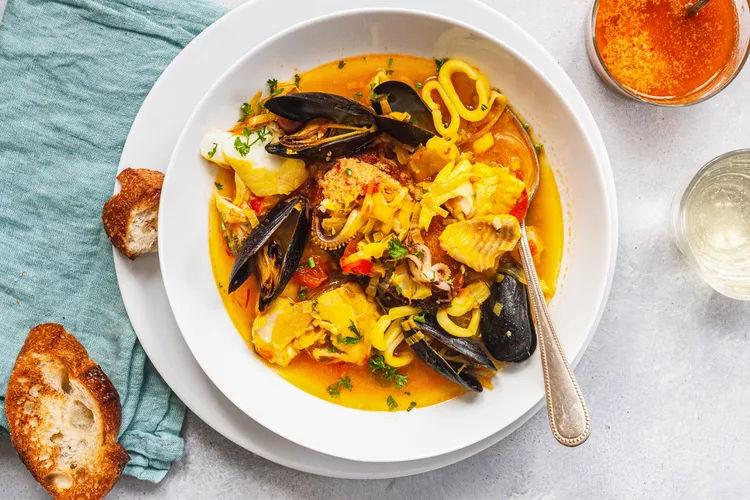
4) Bouillabaisse
Bouillabaisse is a traditional French fish stew from Marseille. Fishermen originally made it to use up bony fish. Today, it’s a sought-after dish with a complex flavor profile.
To make bouillabaisse, you need a mix of various fish and shellfish. Common choices include sea bass, red mullet, and monkfish. Fresh ingredients are essential for the best flavor.
Start by cooking onions, leeks, and fennel in olive oil. Add garlic and tomato paste. Then, pour in water and wine, bringing the mix to a boil.
Fish bones are important for making the broth rich. Boil fish bones with the vegetables and then strain the broth. This step adds depth to the soup.
The stew often includes potatoes and saffron. Saffron gives it a golden color and unique taste. Simmer until the potatoes are tender.
Make a rouille sauce on the side. Rouille is a garlicky mayonnaise often served with bouillabaisse. It’s made by blending garlic, bread, cayenne, and saffron with olive oil.
Serve the bouillabaisse hot with slices of crusty bread. The dish is hearty and flavorful, perfect for seafood lovers.
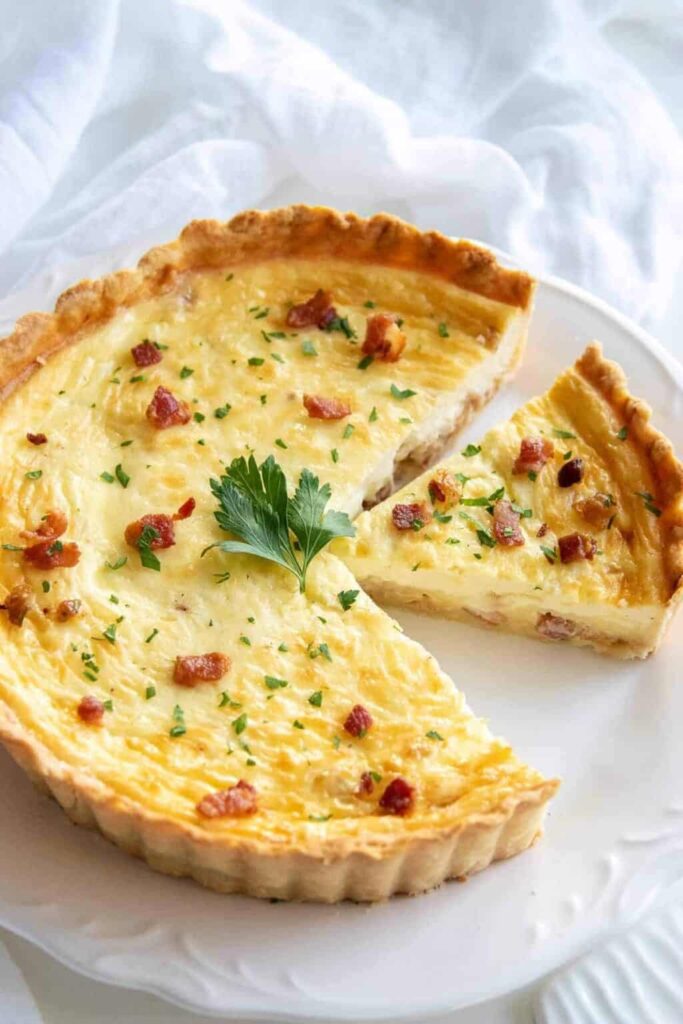
5) Quiche Lorraine
Quiche Lorraine is a classic French dish that combines a rich, creamy filling with a flaky crust. It’s perfect for breakfast, brunch, or even dinner.
To start, you need a good pie crust. Roll out the dough and fit it into your pie or tart pan. Prick the bottom with a fork to prevent bubbles.
Next, prepare the filling. Whisk together eggs, heavy cream, and a bit of whole milk. Add salt, a pinch of cayenne pepper, and a little nutmeg for flavor.
Cook some bacon until it’s crispy, then crumble it into the pie crust. Spread grated Gruyère cheese over the bacon. Pour the egg mixture over the cheese and bacon.
Bake the Quiche Lorraine in a preheated oven at 350°F until the filling is set and golden brown on top. This will take about 30-35 minutes.
Let it cool slightly before serving. You can enjoy it warm or at room temperature. Its savory taste makes it a favorite for many occasions.
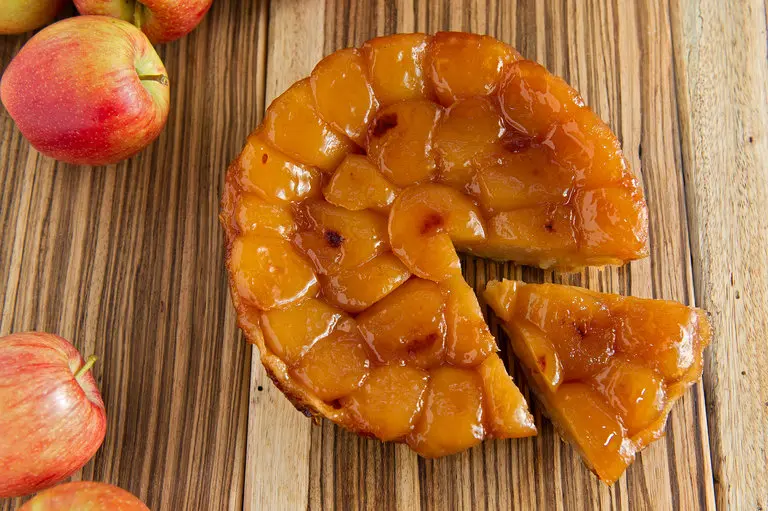
6) Tarte Tatin
Tarte Tatin is a traditional French dessert that features caramelized apples and a buttery, flaky pastry.
Begin by melting butter in a cast iron skillet over medium heat. Add sugar and vanilla bean scrapings. Stir until the sugar dissolves. Once the mixture simmers, add the apple quarters and coat them well.
Next, reduce the heat to low and cook the apples until they soften.
Roll out your shortcrust pastry dough and lay it over the apples in the skillet. Tuck the edges of the pastry around the apples to enclose them.
Preheat your oven to 400°F (200°C). Place the skillet in the oven and bake for 25-30 minutes until the pastry is golden and crispy.
When done, let the tart cool slightly. Carefully invert the skillet onto a serving plate to reveal the caramelized apples.
Serve warm, perhaps with a dollop of crème fraîche or a scoop of vanilla ice cream.
This dessert is perfect for impressing guests with its rich flavors and beautiful presentation. Enjoy!
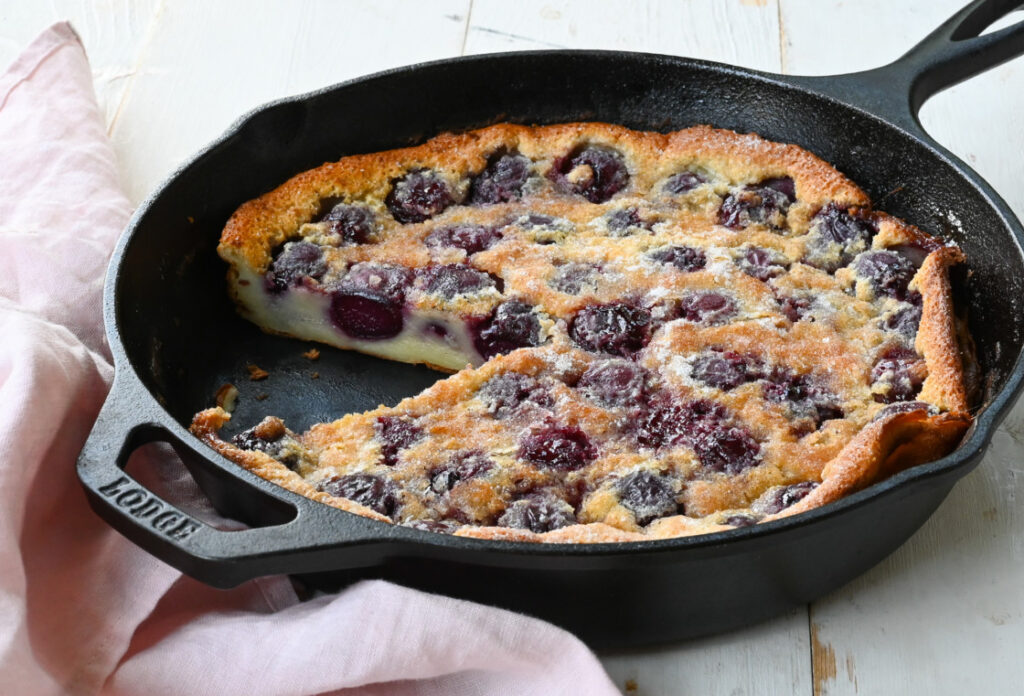
7) Clafoutis
Clafoutis is a classic French dessert made with fresh cherries. You bake it with a simple batter that results in a custard-like texture. It’s a favorite in many French households.
Start by preheating your oven to 350°F. Butter a pie dish or a cast iron skillet. Arrange fresh cherries evenly in the dish.
In a bowl, whisk together milk, sugar, eggs, and vanilla. Gradually add flour and salt, and keep whisking until the mixture is smooth without lumps.
Pour the batter over the cherries in the dish. Bake for about 30-40 minutes, or until the clafoutis is golden brown and set in the center.
Let it cool slightly before serving. You can dust it with powdered sugar for extra sweetness. Clafoutis is best enjoyed warm.
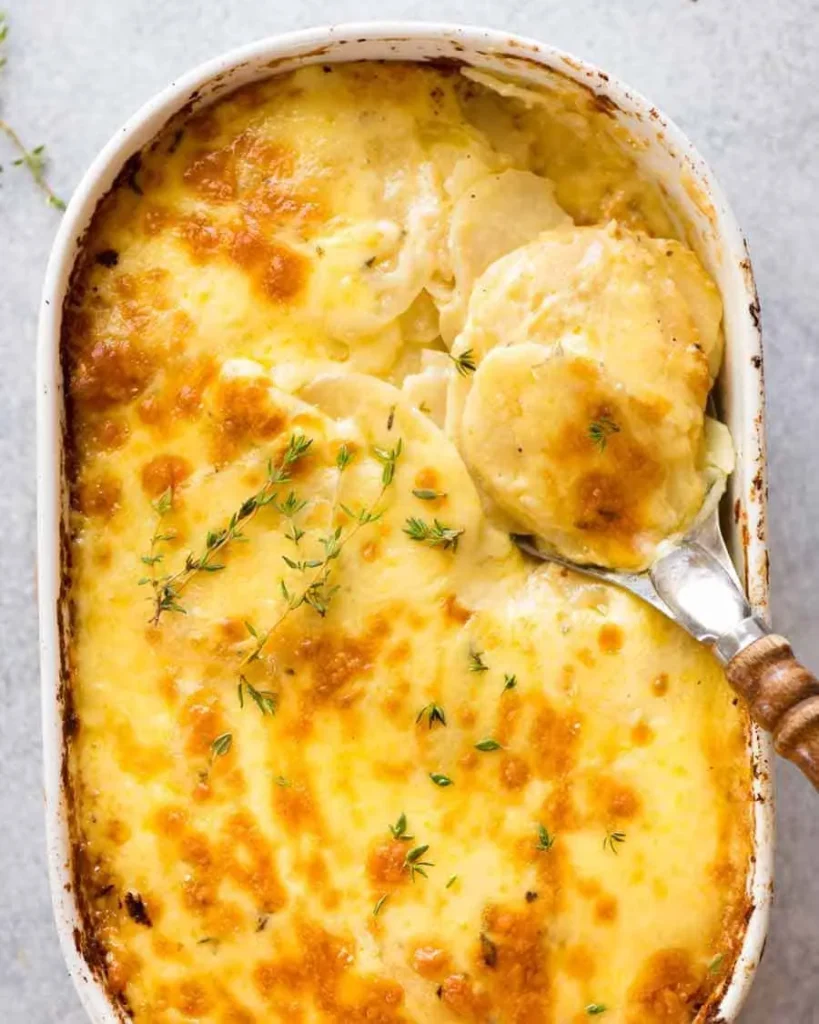
8) Gratin Dauphinois
Gratin Dauphinois is a classic French dish from the Dauphiné region. This rich and creamy side dish features thinly sliced potatoes baked in a mixture of milk and cream. It’s the perfect accompaniment to many main courses.
To make Gratin Dauphinois, start by peeling and slicing potatoes very thinly. You can use a mandoline slicer for this. Preheat your oven to 350°F (180°C).
In a large pot, combine cream, milk, nutmeg, pepper, and salt. Bring this mixture to a simmer over medium heat. Add the potato slices to the pot and cook gently until they are just tender.
Layer the potatoes in a baking dish, pouring some of the cream mixture over each layer. Continue until all the potatoes and cream are used up. Bake in the preheated oven until the top is golden and bubbly.
Serve your Gratin Dauphinois hot. The creamy, tender potatoes will melt in your mouth and delight your taste buds. This comforting dish is sure to be a hit at any meal.
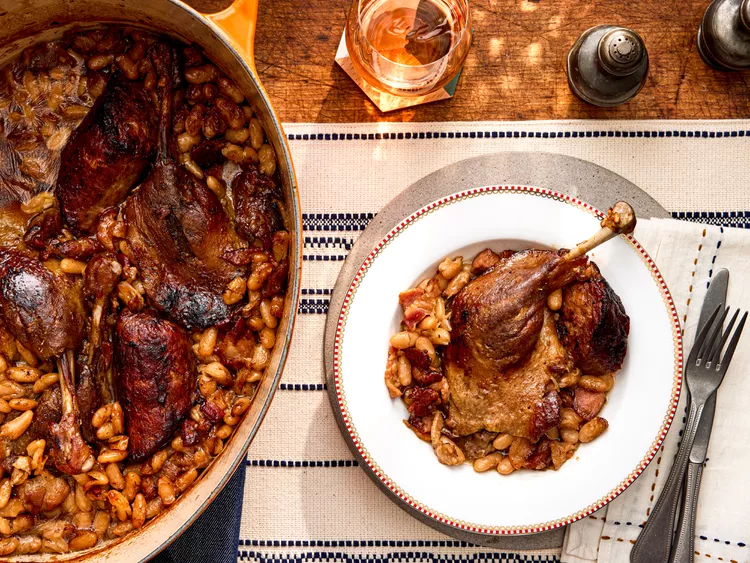
9) Cassoulet
Cassoulet is a classic French dish known for its rich flavors and hearty ingredients. This slow-cooked casserole traditionally features beans, pork, sausages, and confit duck.
To make cassoulet, you start with a sturdy pot or Dutch oven. Brown the meat in batches until all sides are seared. Remove the meat and set it aside.
Next, cook vegetables like onions, carrots, and celery in the pot. Scrape up any browned bits to add extra flavor. Add garlic, bay leaves, and a mix of herbs for seasoning.
Return the meat to the pot and add beans, usually white beans or flageolets. Pour in enough stock to cover everything. Bring the mixture to a simmer.
Transfer the pot to a preheated oven. Bake uncovered at 325ºF for about 1-1.5 hours. Occasionally break the crust with a spoon and add extra liquid if needed to keep it moist.
Once the casserole has thickened and the flavors melded together, it’s ready to serve. Garnish with fresh parsley before serving. Enjoy the comfort and warmth of this traditional French dish.
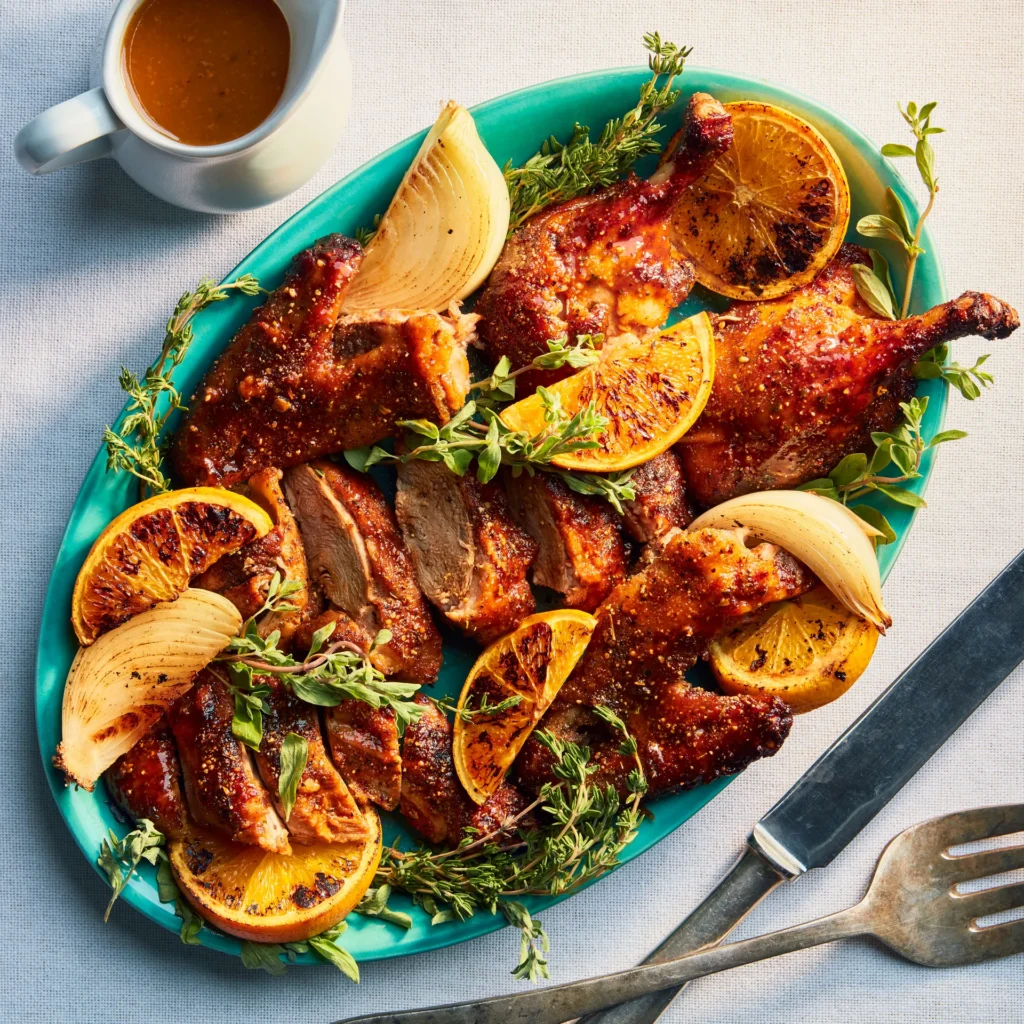
10) Duck à l’Orange
Duck à l’Orange is a classic French dish. It’s known for its savory duck paired with a sweet and tangy orange sauce. This recipe takes time but is worth the effort.
First, you roast the duck until it is golden brown. The roasting process can take about an hour. Make sure to keep an eye on it to avoid overcooking.
While the duck roasts, you prepare the orange sauce. Start by straining the drippings from the roasting pan. This adds rich flavor to your sauce. Next, mix in orange juice and marmalade in a saucepan and bring it to a boil.
For an extra kick, you can add Grand Marnier. It enhances the orange flavor without overwhelming the dish. Add salt and orange bitters to taste, making sure not to overpower the sauce’s balance.
You can dehydrate orange slices to use as a garnish. This step isn’t essential but adds a nice touch. Simply sprinkle with icing sugar and bake until they are mostly dehydrated.
Duck à l’Orange is ideal for festive occasions or special dinners. With its combination of flavors, it’s sure to impress your guests.
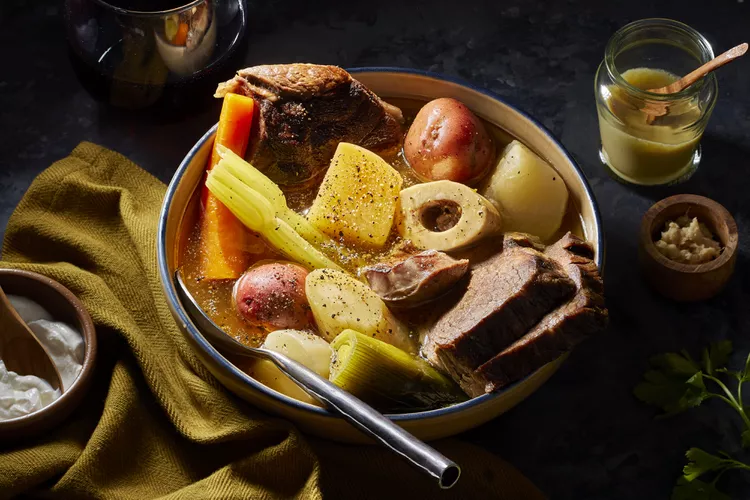
11) Pot-au-Feu
Pot-au-Feu is a beloved French dish known for its heartiness. It’s traditionally a beef stew, cooked slowly with vegetables. You’ll find it comforting and perfect for colder months.
To prepare Pot-au-Feu, start with a mix of beef cuts like chuck, shank, and short ribs. Add marrow bones for extra flavor. Place them in a large pot.
Next, include aromatic ingredients such as thyme, bay leaves, peppercorns, and a generous pinch of salt. Add onions and garlic to enhance the taste. Cover everything with cold water and bring to a boil.
Once it boils, lower the heat to a gentle simmer. Skim off impurities that rise to the surface. This keeps the broth clear and tasty. Let it cook for several hours.
Add whole vegetables like carrots, leeks, and turnips. Separate the potatoes and add them towards the end. This ensures they don’t overcook and become mushy.
After simmering for around two and a half hours, the meat should be tender. Remove the meat and vegetables. Serve the broth as a starter. Follow with the meat and vegetables on a platter.
Pot-au-Feu is typically served with coarse salt and mustard on the side. Some also enjoy it with cornichons or pickled onions. This dish truly embodies the essence of French home cooking.
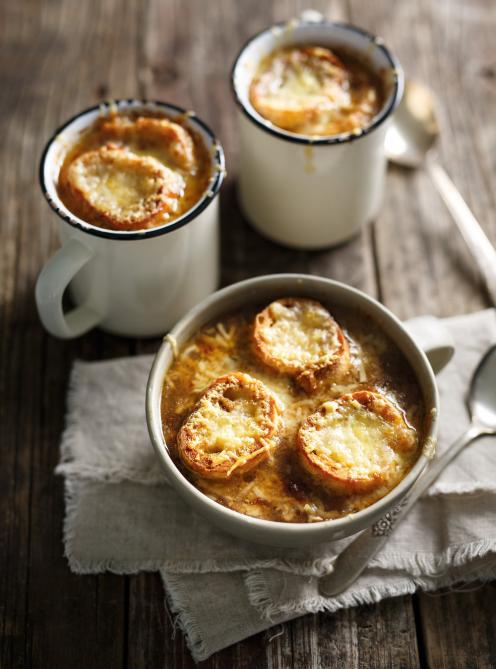
12) Soupe à l’Oignon
Soupe à l’Oignon, known as French Onion Soup in English, is a classic dish that originated in France. It’s made with onions, broth, and topped with melted cheese on slices of French baguette.
To start, you need to caramelize the onions. This process can take up to two hours. Use a large pan, melt butter, and add thinly sliced onions. Stir occasionally until the onions turn golden brown.
Next, deglaze the pan with white wine or water. This helps to lift any browned bits from the bottom of the pan, adding extra flavor. Pour this mixture into the pot with the onions.
Add your broth to the pot. You can use beef, chicken, or even vegetable broth. Bring the mixture to a gentle simmer. Season with salt and pepper to taste.
To finish, ladle the soup into oven-proof bowls. Place slices of French baguette on top and sprinkle generously with grated cheese, usually Gruyère or Comté.
Place the bowls under a broiler until the cheese is melted and bubbly. Serve it hot and enjoy the rich, savory flavors of this traditional French dish.
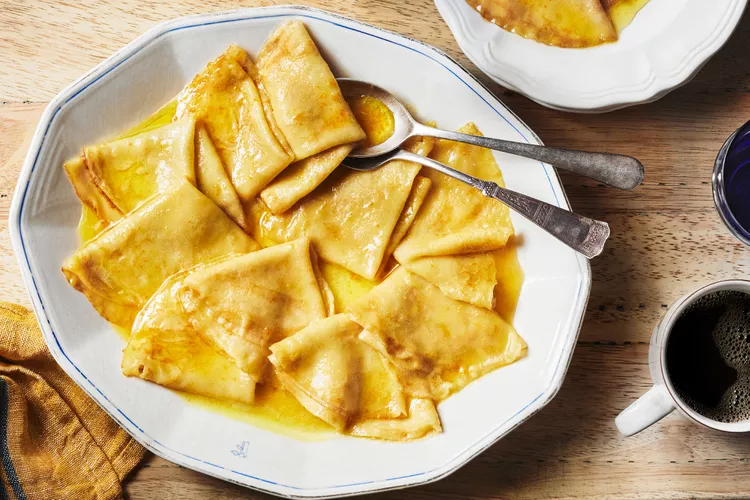
13) Crêpes Suzette
Crêpes Suzette is a classic French dessert. It’s known for its thin, delicate crêpes and rich orange-flavored sauce.
To make the crêpes, you first prepare a simple batter with flour, eggs, milk, and a bit of sugar. Let the batter rest for about 30 minutes. This helps the crêpes have a smooth texture.
Heat a non-stick pan over medium heat. Lightly brush it with butter. Pour a small amount of batter into the pan, swirling to cover the bottom. Cook for about a minute until light brown, then flip and cook the other side.
The sauce, known as beurre Suzette, is made with butter, orange juice, orange zest, and sugar. Sometimes, orange liqueur like Grand Marnier is added for extra flavor. Heat the sauce in a pan until it thickens slightly.
Place each crêpe in the sauce, folding them into quarters. Once all crêpes are coated and warmed, serve them immediately. Crêpes Suzette is often flambéed at the table for a dramatic presentation, but this step is optional.
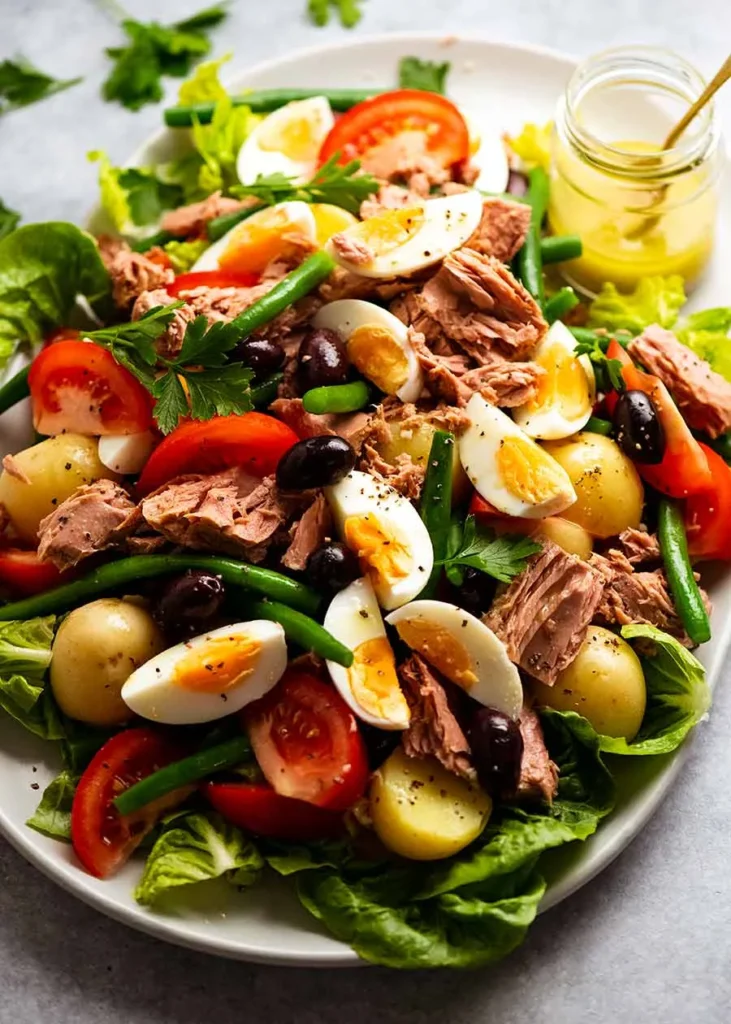
14) Salade Niçoise
Salade Niçoise is a staple of French cuisine, hailing from the city of Nice. This vibrant salad is colorful and packed with fresh ingredients.
You need fresh greens, tomatoes, olives, hard-boiled eggs, and tuna. Potatoes and green beans are often included. Each ingredient should be fresh to keep the flavors bright.
Start by boiling the potatoes and green beans until tender. Simultaneously, boil the eggs until hard-boiled. Let them cool before peeling and quartering the eggs.
For the vinaigrette, whisk together olive oil, vinegar, basil, and garlic. Season with salt and pepper. This dressing ties the salad together, adding a zesty flavor.
To assemble, place the greens on a large platter. Arrange the potatoes, green beans, tomatoes, olives, and tuna artfully. Drizzle the vinaigrette over the top.
Finish by adding the quartered eggs and any extra herbs you like, such as parsley or chives. Serve immediately.

15) Croissants
Croissants are a classic French pastry known for their flaky, buttery layers. They may seem tricky to make, but with patience, you can enjoy fresh, homemade croissants.
Start by preparing the dough, known as the détrempe. This includes flour, water, milk, sugar, salt, and yeast. Mix these ingredients until a dough forms, then refrigerate.
The key to flaky layers is laminating the dough with butter. Roll out the détrempe and place cold butter in the center. Fold the dough over the butter and roll it out again. Repeat this process several times, chilling the dough between folds.
After all the folding, shape the dough into croissants. Roll it out into a large rectangle, cut into triangles, and roll each triangle from the base to the tip. Bend the ends slightly to create the signature crescent shape.
Place the shaped croissants on a baking sheet and let them rise until doubled in size. This can take 1-2 hours. Once risen, brush them with an egg wash to give them a glossy finish.
Bake the croissants in a preheated oven until they are golden brown. Once out of the oven, let them cool slightly on a rack before enjoying.
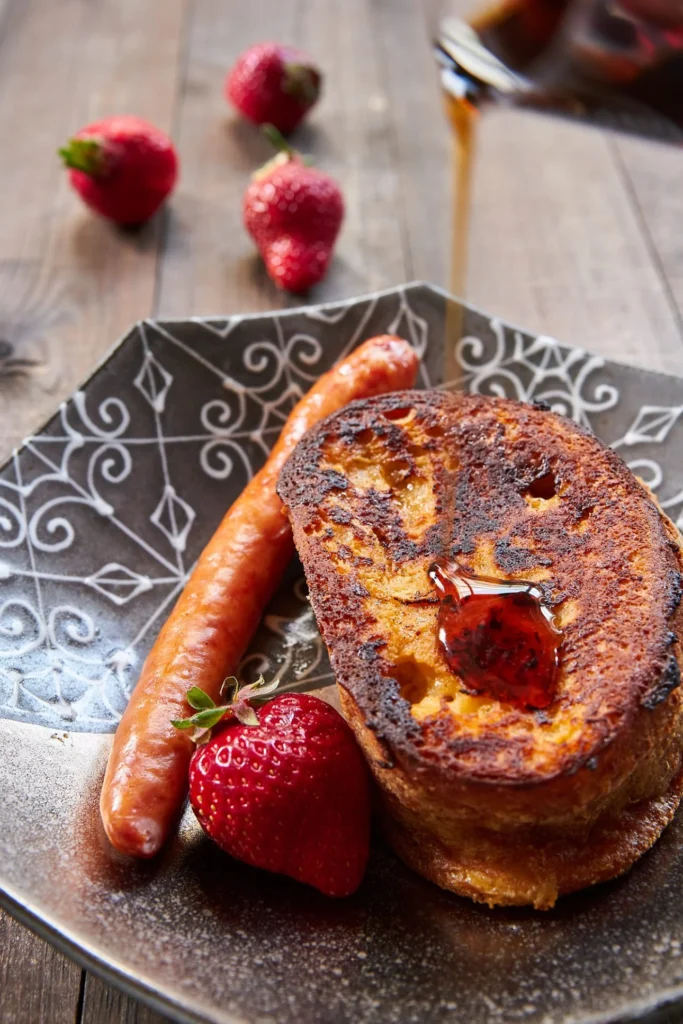
16) Pain Perdu
Pain Perdu, also known as French Toast, is a classic French breakfast dish. It’s a great way to use up stale bread and turn it into a delicious meal.
To make Pain Perdu, you need slices of slightly stale bread, preferably a baguette or brioche. The bread should be about 2 inches thick.
In a shallow bowl, whisk together eggs, milk, sugar, and a pinch of salt. You can also add vanilla extract and orange zest for extra flavor.
Soak each slice of bread in the egg mixture for about 3 minutes on each side. This helps the bread absorb the mixture and become soft and flavorful.
Heat a skillet or frying pan over medium heat and add a bit of butter. Fry the soaked bread slices until golden brown and crispy on both sides.
Serve your Pain Perdu warm, with a dusting of powdered sugar, a drizzle of syrup, or fresh fruit. This simple yet tasty dish is sure to be a hit at breakfast.
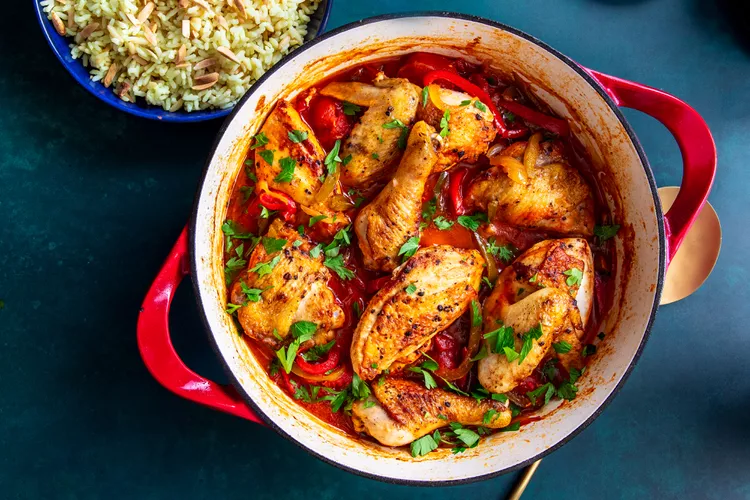
17) Poulet Basquaise
Poulet Basquaise is a classic chicken dish from the Basque region of France. Known for its rich flavors, this recipe highlights the use of fresh, local ingredients.
First, season the chicken with salt, pepper, and a touch of piment d’Espelette. Heat olive oil in a large pot or Dutch oven over medium-high heat. Brown the chicken on all sides until golden.
In the same pot, sauté onions, garlic, and bell peppers until they soften. This usually takes about 10 to 15 minutes. Then, add tomatoes and let everything cook for another 20 minutes, stirring occasionally.
Next, add the browned chicken back into the pot. If you have a bouquet garni, include it now. Lower the heat to medium-low and let the chicken simmer for about 30 minutes until fully cooked and tender.
Serve Poulet Basquaise with rice or crusty bread to soak up the delicious sauce. This hearty dish is perfect for any occasion and brings a taste of the Basque region to your table.
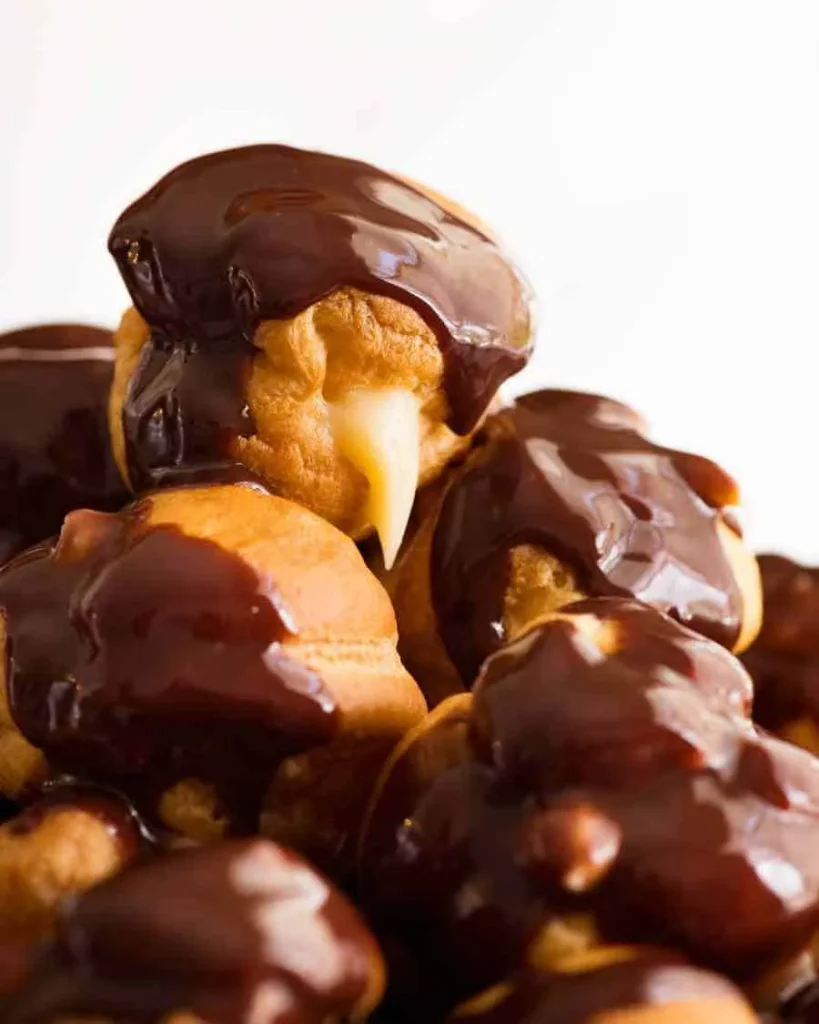
18) Profiteroles
Profiteroles are a classic French dessert made from choux pastry filled with cream or ice cream and topped with chocolate sauce. To make the choux pastry, preheat your oven to 400°F (200°C). Line a baking sheet with parchment paper.
In a saucepan, bring water and butter to a boil over medium heat. Remove from heat and quickly mix in flour, salt, and sugar with a wooden spoon. Return to heat and stir until the dough forms a ball and pulls away from the sides.
Let the dough cool for a few minutes, then beat in eggs one at a time until smooth. Transfer the dough to a piping bag with a 1A tip. Pipe small mounds onto the baking sheet, about 2 inches apart. Bake for 30-35 minutes until golden and firm.
Let the choux buns cool completely. Once cooled, you can fill them with whipped cream or vanilla ice cream using a pastry bag. For the whipped cream, beat 2 cups of heavy cream with 1/4 cup sugar and 1 teaspoon vanilla extract until firm peaks form.
Top the filled profiteroles with chocolate sauce. Melt your favorite chocolate with a little cream and drizzle over the profiteroles. Serve immediately or freeze the filled profiteroles to enjoy later.
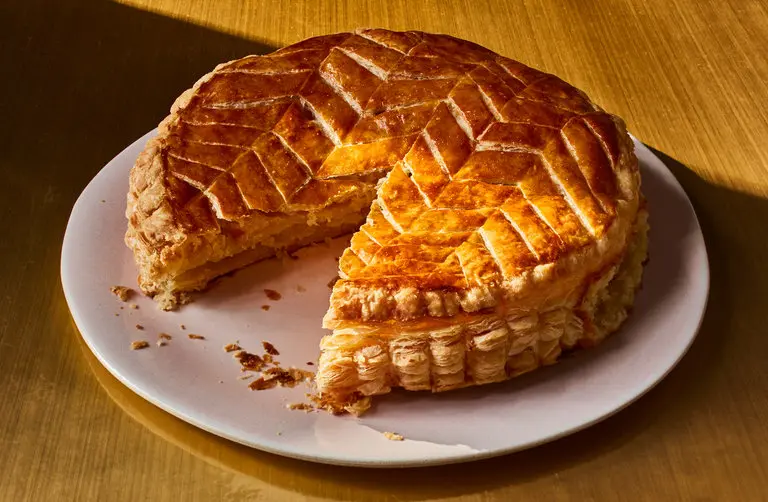
19) Galette des Rois
Galette des Rois, or King Cake, is a traditional French pastry enjoyed during Epiphany. It’s known for its flaky puff pastry and creamy almond filling.
To make the filling, mix almond flour, sugar, salt, and orange zest. Add butter and eggs one by one, then stir in rum and almond extract. This creates a rich, flavorful paste.
For the pastry, roll out puff pastry and cut two circles about 8 inches in diameter. Prick the pastry with a fork. Place one circle on a baking sheet lined with parchment paper and spread the almond cream evenly.
Cover with the second circle of pastry, sealing the edges. Brush the top with beaten egg. Score a pattern on the surface and bake at 425°F until golden brown. This creates a beautiful, crispy cake.
Traditionally, a small charm or “fève” is hidden inside. The person who finds it in their slice becomes king or queen for the day. Remember to warn your guests about the charm to avoid surprises.
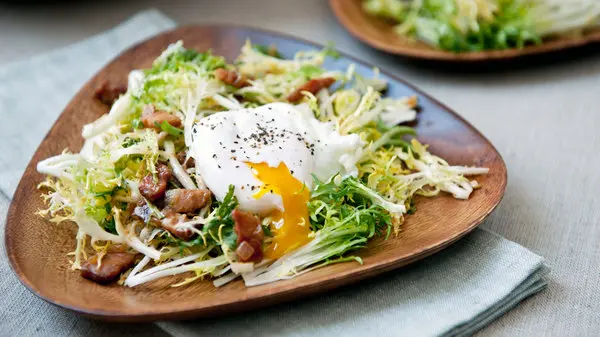
20) Salade Lyonnaise
Salade Lyonnaise is a classic French salad that comes from the city of Lyon. This dish combines fresh frisée greens with crispy bacon and a warm vinaigrette dressing. It’s usually topped with a poached egg.
To start, you will need frisée, which is a type of curly endive. Its slightly bitter taste contrasts well with the rich flavors in the salad.
Cook bacon in a skillet over medium heat until crisp. Use the rendered bacon fat to make the dressing. Add a bit of vinegar and Dijon mustard, whisking until smooth.
Afterward, toss the frisée with the warm bacon vinaigrette. This ensures that every piece of green is coated with flavor. Season with salt and pepper to taste.
Next, poach the eggs. Bring a pot of water to a gentle simmer. Crack each egg into a small bowl and then gently slide it into the water. Cook until the whites are set, but the yolks are still runny.
Place the poached egg on top of the salad. The runny yolk mixes with the dressing, adding extra richness. Serve immediately to enjoy the perfect blend of textures and flavors.
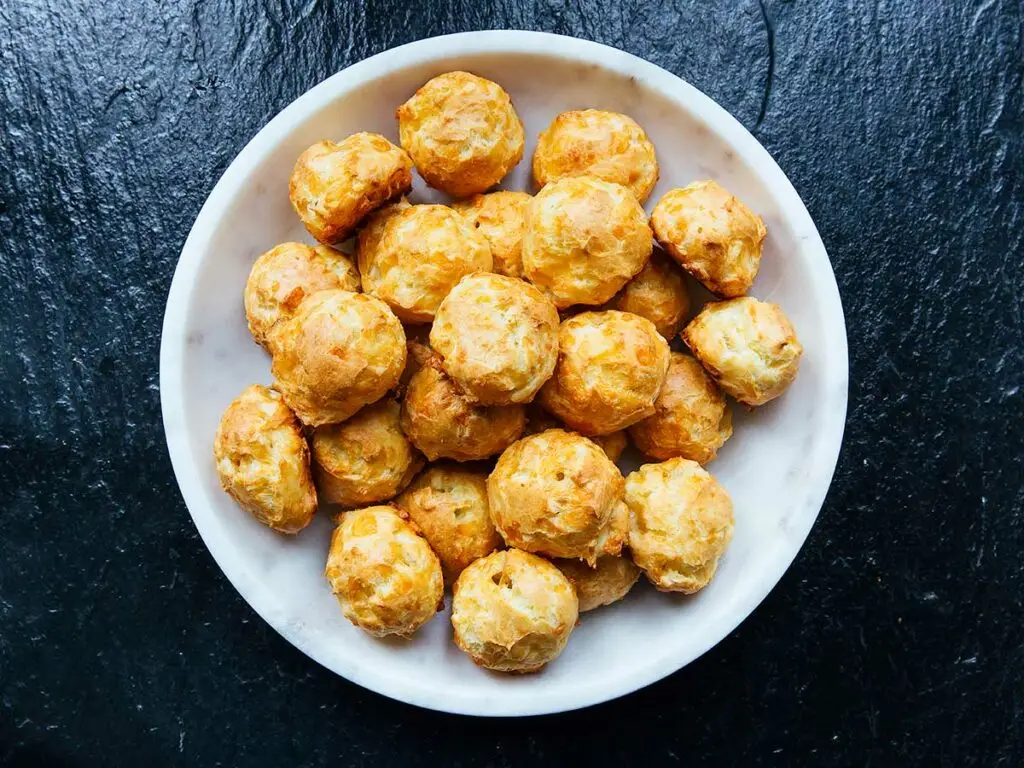
21) Gougères
Gougères are delightful French cheese puffs that are perfect as appetizers or snacks. They are made from pâte à choux, a versatile dough used in many French pastries.
To make gougères, you need basic ingredients like water, butter, flour, eggs, and cheese. Start by boiling water with butter and a pinch of salt. This ensures the dough has a rich flavor.
Once the mixture boils, add flour all at once. Stir until the dough comes together. The dough should be smooth and pull away from the sides of the pot. This step takes about 1-2 minutes.
Remove the pot from heat and let it cool slightly. Begin adding eggs one at a time, beating the dough well after each egg. This makes the dough light and airy.
Finally, mix in shredded cheese. You can use Gruyère, Comté, or even cheddar. Scoop tablespoon-sized balls of dough onto a baking sheet lined with parchment paper, leaving space between each.
Bake the gougères at 425°F, then turn the temperature down to 375°F. Bake for around 15 minutes, rotating the pans halfway to ensure even cooking. The result is golden puffs with a crisp exterior and a soft, cheesy center. Enjoy them warm for the best flavor.
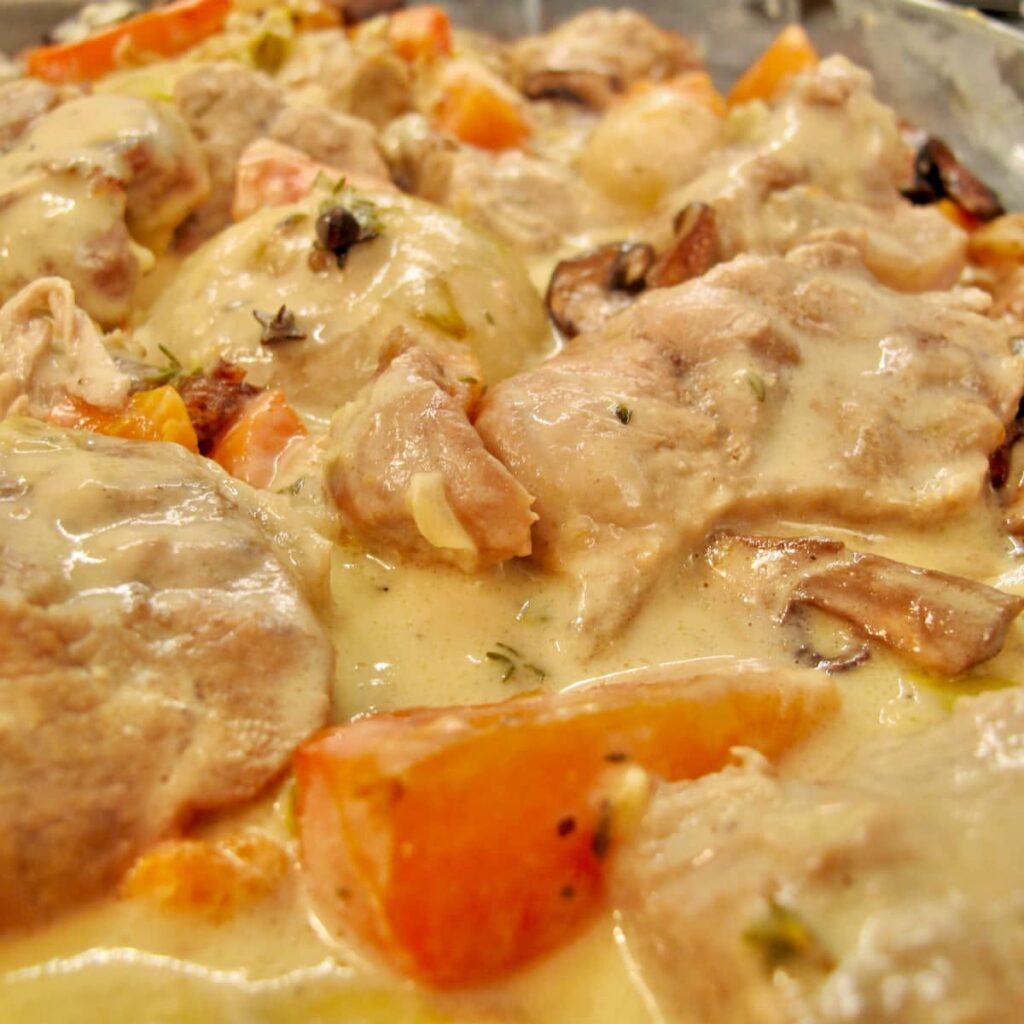
22) Blanquette de Veau
Blanquette de Veau is a classic French veal stew that is rich and comforting. It is made with tender pieces of veal, slow-cooked with vegetables and a creamy sauce.
You start by cutting the veal into large cubes. Rinse the veal under cold water, then place it in a large pot and cover with water. Bring the pot to a boil and skim off any impurities that rise to the surface.
Add carrots, leeks, onions, and a bouquet garni to the pot. Season with salt and pepper. Reduce the heat and let it simmer for about an hour and a half, until the veal is tender.
In a separate pan, sauté mushroom slices in butter until they are soft. Boil small onions until their skins peel off easily. Cook these onions in some of the veal broth.
In a small bowl, mix butter and flour to make a paste. Whisk this paste into the hot liquid from the pot until smooth. This helps to thicken the sauce.
Combine all ingredients back in the pot. Simmer together for a few minutes before serving. The result is a creamy, delicious stew that highlights the tender veal and savory vegetables.
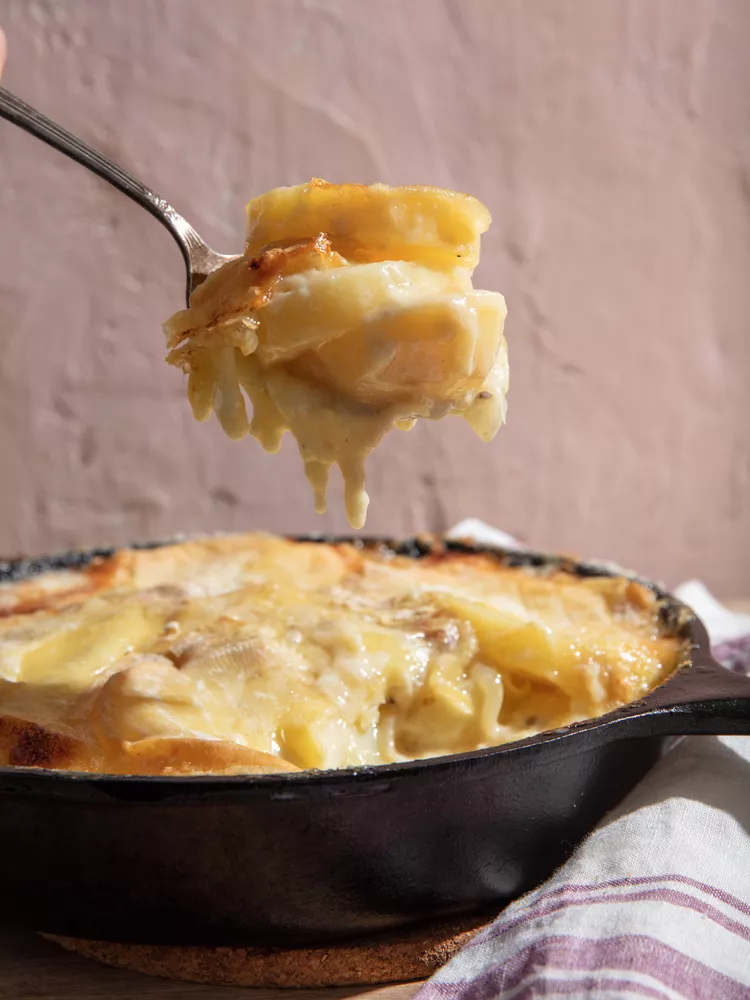
23) Tartiflette
Tartiflette is a rich, savory dish from the French Alps. It’s perfect for cold weather and features layers of ingredients that blend together beautifully.
To start, preheat your oven to 350°F (180°C). Peel and slice potatoes, then boil them until they are just tender. Drain and set them aside.
In a skillet, cook diced bacon until crispy. Remove the bacon, leaving the fat in the skillet. Add sliced onions and cook until they are translucent.
Next, layer half of the sliced potatoes in a baking dish. Sprinkle half of the cooked bacon over them, followed by half of the onions. Pour half of the cream over the top. Repeat with the remaining ingredients to create two layers.
Top the dish with Reblochon cheese, ideally cut in half horizontally. Place the cheese rind side up for a perfect melt. Bake until bubbly and golden brown, typically 20-25 minutes.
Serve Tartiflette warm, ideally with a side salad and pickles. This hearty meal will transport you to a cozy chalet in the Alps.
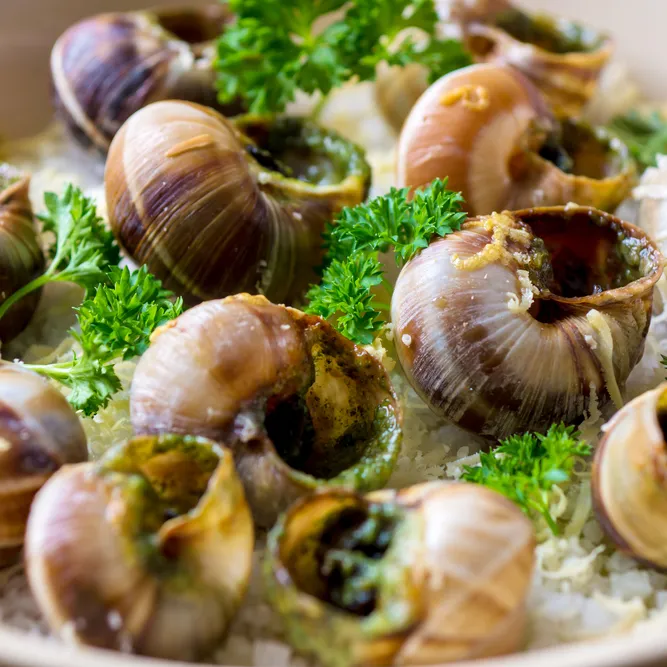
24) Escargots de Bourgogne
Escargots de Bourgogne, or Burgundy snails, are a famous French delicacy. They are typically served as an appetizer. The dish involves snails cooked with garlic, parsley, and butter, which results in a rich and flavorful experience.
To prepare this dish, you will need fresh or canned snails. Rinse the snails well. Then, make a mixture of butter, finely chopped parsley, minced shallots, and garlic. Some recipes also suggest adding a splash of brandy or white wine for extra flavor.
Preheat your oven to 350°F (180°C). Place each snail into its shell or an escargot dish. Fill each one with the butter mixture. Make sure the snails are submerged to absorb all the flavors during baking.
Bake the snails for about 10-15 minutes, until the butter is bubbling and the snails are heated through. Serve them hot, usually accompanied by crusty bread to soak up the delicious garlic butter.
Escargots de Bourgogne is not only a treat for the taste buds but also a piece of French culinary tradition.
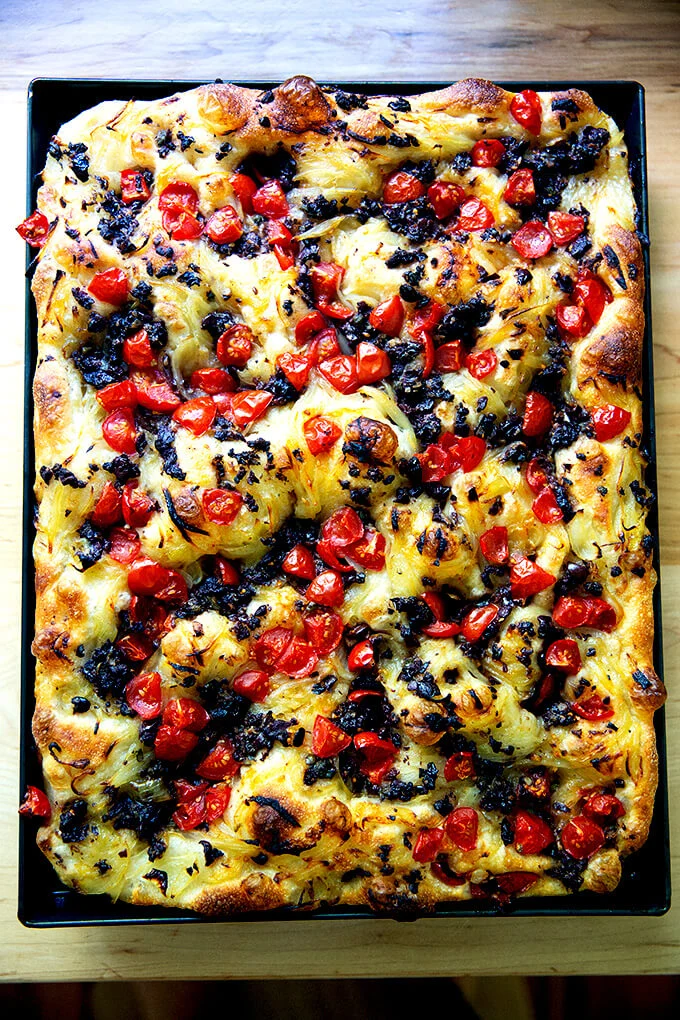
25) Pissaladière
Pissaladière is a traditional dish from the South of France. It’s often compared to a pizza, but it has a unique taste and preparation method. This savory tart is typically topped with caramelized onions, anchovies, and black olives.
To make Pissaladière, start with a dough that can be a pizza or bread dough. Roll it out and preheat your oven to around 400°F (200°C).
Caramelizing the onions is key. Slice your onions thinly and cook them slowly with garlic, thyme, and a bit of chopped anchovy until they are soft and golden. This can take up to 45 minutes.
Once the onions are ready, spread them evenly over the rolled-out dough. Arrange anchovy fillets in a crisscross pattern over the onions. Add black olives in the gaps.
Bake the assembled tart in the preheated oven until the edges are golden and crispy, usually about 15-20 minutes.
Serve Pissaladière warm or at room temperature. It’s perfect as a snack, appetizer, or light meal. Enjoy the blend of sweet onions, salty anchovies, and tangy olives!
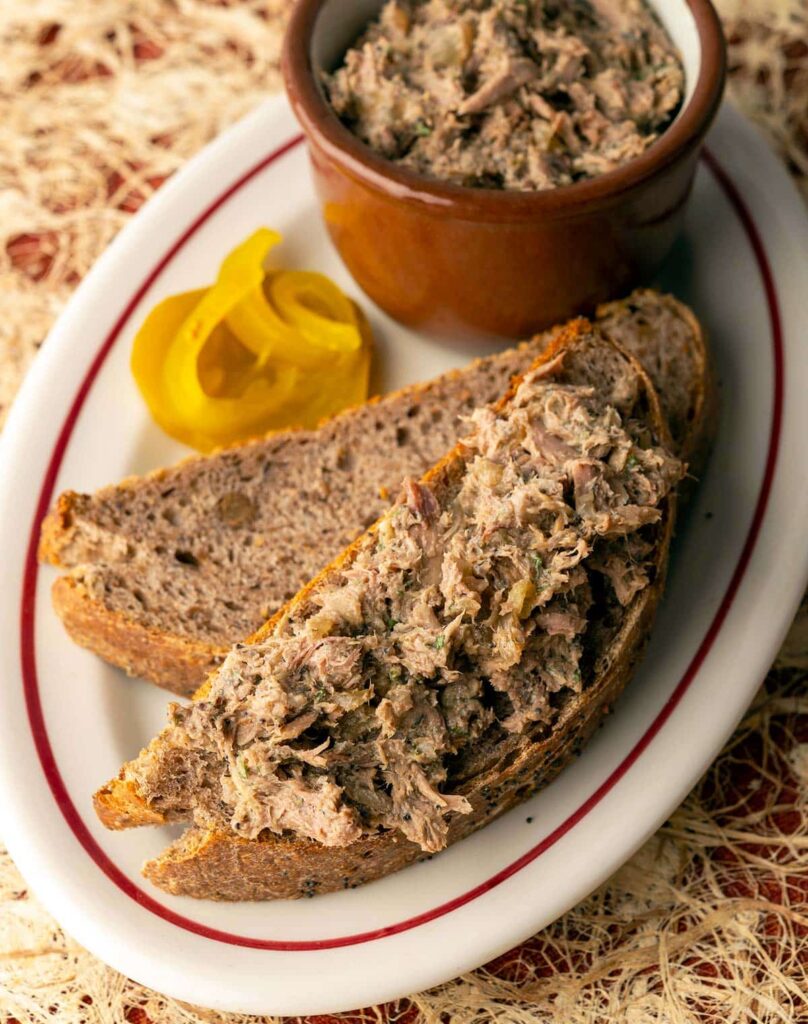
26) Rillettes
Rillettes are a classic French spread made from slow-cooked pork. The meat is cooked until it is tender enough to be shredded and mixed with its own fat, creating a rich, spreadable consistency.
To make rillettes, you’ll typically use cuts like pork shoulder, belly, or sometimes duck. These are braised in the oven with spices and sometimes wine or cider.
Once the meat is done cooking, it is shredded and mixed with some of the fat and cooking liquid. This mixture is then packed into containers and chilled. The result is a savory spread that pairs well with crusty bread.
Rillettes can be flavored with various herbs and spices. Common additions include thyme, rosemary, nutmeg, and sometimes star anise or cinnamon for extra depth.
This dish is often served as an appetizer or as part of a charcuterie board. It captures the rustic, hearty nature of traditional French cooking.
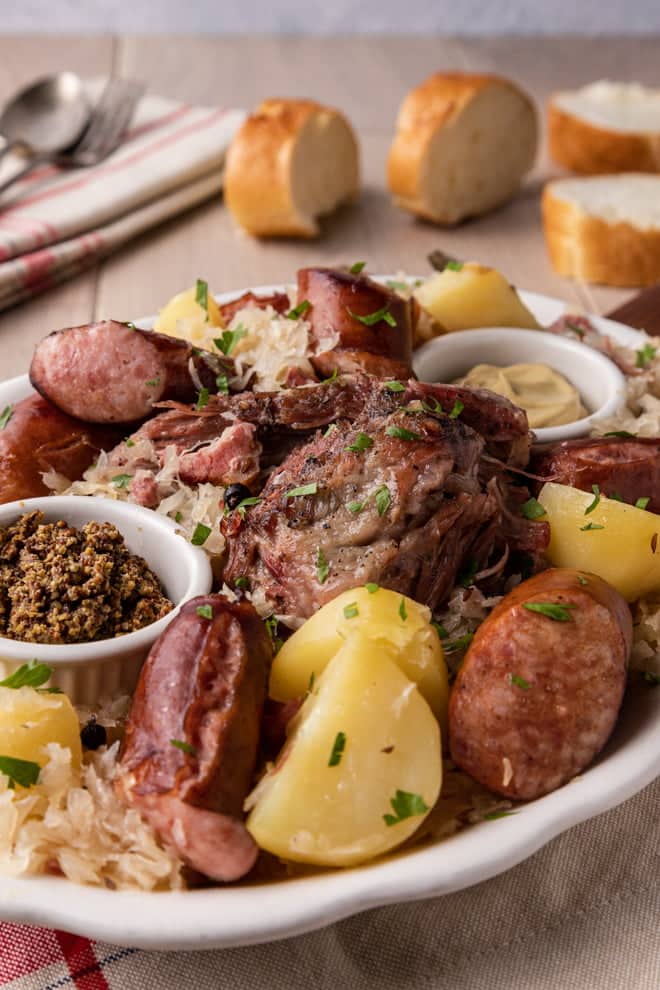
27) Choucroute Garnie
Choucroute Garnie is a famous dish from the Alsace region of France. It combines sauerkraut with a variety of meats.
To start, heat some duck or goose fat in a large pot. Add finely chopped onions and garlic. Cook until they are soft and fragrant, but not browned.
Next, add the sauerkraut, white wine, and some stock. Mix in spices like juniper berries, caraway seeds, and bay leaves. You can also add potatoes and apples for a bit of sweetness.
For the meat, use a mix of pork shoulder, sausages, and bacon. Nestle these into the sauerkraut mixture. Cover the pot tightly with a lid or aluminum foil.
Transfer the pot to a preheated oven set at 250°F (120°C). Let it cook for about 2 hours. The low temperature allows the flavors to blend together. The meat will be tender, and the sauerkraut will be flavorful.
Serve Choucroute Garnie hot, straight from the pot. This hearty dish pairs well with a cold Alsatian white wine. Enjoy your homemade taste of France!
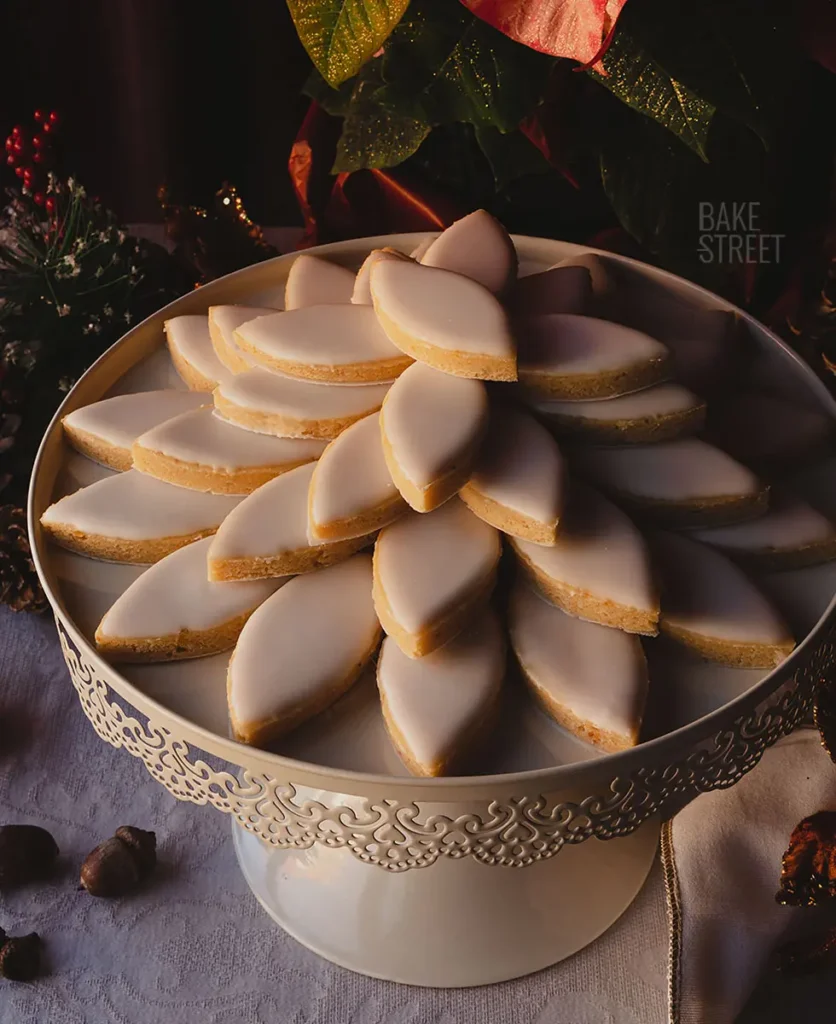
28) Calissons
Calissons are a traditional French candy from Aix-en-Provence. They have a unique flavor with a blend of almonds, candied melon, and orange peel. This candy is often enjoyed during festive occasions and is known for its smooth and slightly chewy texture.
To make calissons, you need ground almonds, confectioners’ sugar, and orange blossom water. You mix these ingredients and cook them into a smooth paste. It’s important to handle the paste carefully as it can be quite sticky.
Once the paste is ready, let it cool. After cooling, you can shape it using oval cookie cutters. Dipping the tops in icing sugar gives calissons their signature glaze.
A traditional recipe also includes soaking candied melon and orange peel in almond liqueur and orange flower water. This adds extra flavor to the candy. The mixture is then drained before adding it to the almond paste.
Calissons can be a bit challenging to make but are worth the effort. They represent a special part of French confectionery traditions and are a delightful treat to share.
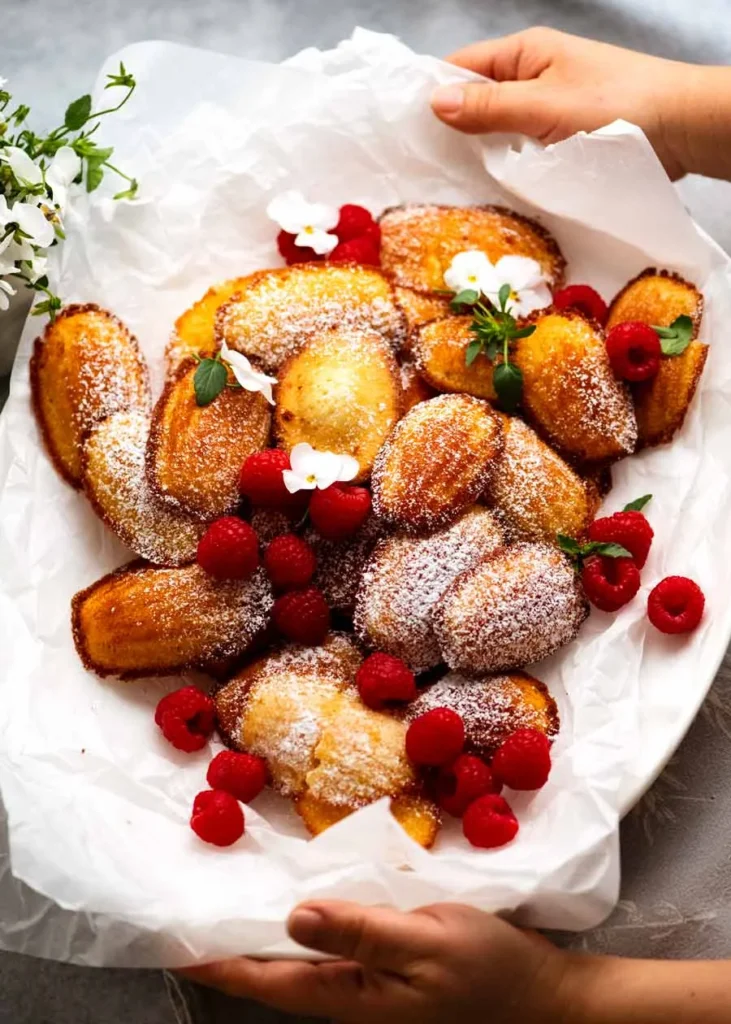
29) Madeleines
Madeleines are small sponge cakes with a distinctive shell shape. They are traditionally baked in a special pan with shell-shaped molds. These cakes have a delightful buttery flavor and a light, fluffy texture.
To make Madeleines, you mix sugar, eggs, and vanilla extract until the mixture is thick and pale. This step usually takes around 4-5 minutes of whisking. Then, you combine this mixture with flour, baking powder, and a pinch of salt.
The batter also includes melted butter that has been cooled. Some recipes may call for additional ingredients like lemon zest or milk. It’s important to refrigerate the batter for at least an hour or even up to two days. This helps in achieving the traditional “hump” on the back of the Madeleines.
When you’re ready to bake, preheat your oven to around 375°F (190°C). Grease your Madeleines pan well with butter and dust it lightly with flour. Fill each mold about three-quarters full.
Baking typically starts with a high temperature, around 425°F (220°C), for a few minutes. This helps create the signature hump. After that, you can lower the temperature for the remaining bake time. Madeleines should come out golden brown and slightly crisp on the edges.
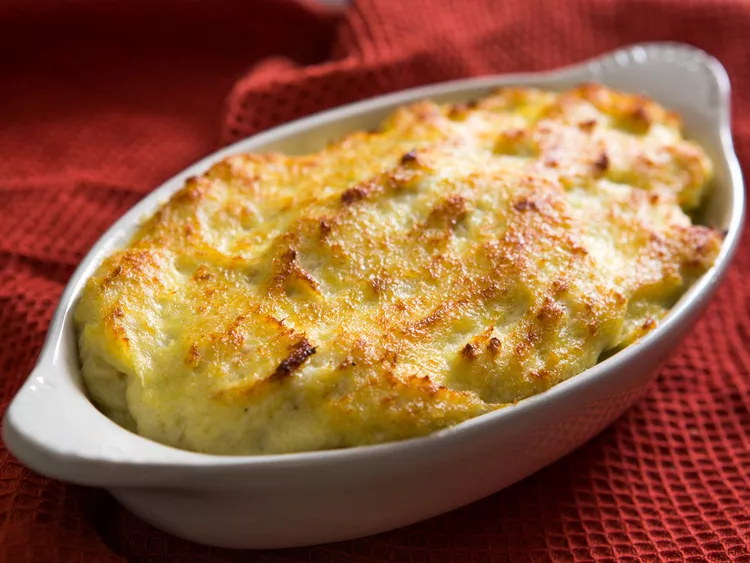
30) Brandade de Morue
Brandade de Morue is a classic French dish made from salt cod. This creamy spread has been a favorite in France for centuries. It combines the saltiness of the cod with the smoothness of cream and a hint of garlic.
To prepare Brandade de Morue, soak the salt cod in water for at least 24 hours, changing the water several times. This removes excess salt from the fish. Once the cod is desalted, gently poach it in water with garlic, bay leaf, and thyme for about 15 minutes.
After the cod is cooked, remove any skin and bones. Flake the fish with a fork. In a separate pot, boil some potatoes until tender. Mash the cooked potatoes until smooth.
Combine the mashed potatoes with the flaked cod in a large bowl. Slowly add warm cream and olive oil, stirring until the mixture is smooth. Some recipes suggest blending the ingredients for a finer texture.
Season with salt, pepper, and a dash of nutmeg. The Brandade de Morue can be served warm or at room temperature. It’s often enjoyed with slices of toasted bread or crackers.
The Essence of French Cuisine
French cuisine is renowned for its flavors, techniques, and regional diversity. Understanding its essence requires a look at the methods used in cooking and the influences from various regions in France.
Culinary Techniques
French cooking is known for its rigorous techniques. Sautéing, braising, and roasting are common methods. You should master these to truly appreciate French dishes. Knife skills are crucial. Precision cuts ensure even cooking and presentation. The mother sauces—béchamel, velouté, espagnole, hollandaise, and tomato—are the backbone of many recipes. Pâte à choux and puff pastry are key in French pastry-making. Learning these basics will set a strong foundation for more complex dishes.
Regional Influences
France’s regions offer diverse flavors. Provence is famous for its use of herbs like thyme, rosemary, and basil, and dishes such as ratatouille and bouillabaisse. Brittany is known for its seafood and crêpes. Normandy uses apples and dairy, evident in dishes like tarte tatin and cheese-based sauces. Burgundy showcases rich flavors with beef bourguignon and coq au vin. Each region’s ingredients and traditions provide a unique touch, making French cuisine varied and richly textured. Understanding these influences helps you appreciate the depth and variety of French cooking.
Key Ingredients in French Cooking
French cuisine uses a variety of ingredients to create rich and flavorful dishes. Common components include fresh herbs, spices, cheeses, and dairy products, crucial for traditional recipes.
Herbs and Spices
Herbs and spices play a critical role in French cooking. Bouquet garni, a bundle of herbs like bay leaf, thyme, and parsley, is often used for soups, stocks, and stews.
Thyme and rosemary add depth to roasted meats and vegetables. Herbes de Provence is a blend including thyme, rosemary, and oregano widely used in Southern France.
Pepper and high-quality sea salt are common, ensuring dishes are seasoned perfectly. Tarragon, known for its licorice-like flavor, is essential in sauces such as béarnaise.
Cheese and Dairy
Cheese and dairy are vital to many French dishes. Camembert, Roquefort, and Brie are among the most famous French cheeses. They are used in everything from cheese plates to melted toppings.
Butter is perhaps the cornerstone of French cooking, adding richness to sauces and pastries. Whole milk and heavy cream are staples, with heavy cream often used in velvety sauces and desserts.
Crème fraîche provides a tangy creaminess, essential for many recipes. These dairy products combine to create the luxurious textures and flavors that define French cuisine.
